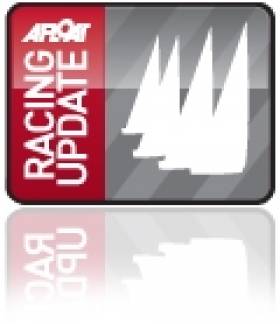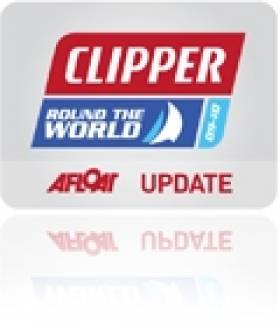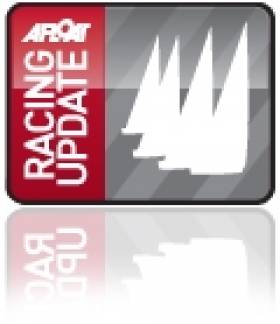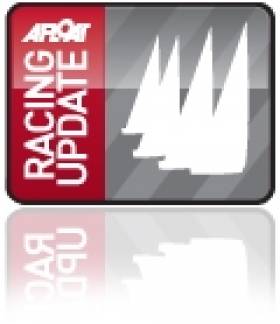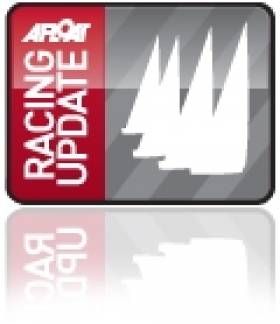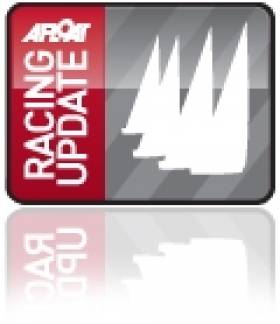Displaying items by tag: Round the Island Race
38ft Classic Yacht Wins Round the Island Race
#rtir – The overwhelming majority of the 1,584-strong fleet has finished the 2015 J.P. Morgan Asset Management Round the Island Race, organised by the Island Sailing Club, after a day of racing in sparkling conditions. Giovanni Belgrano's 38ft classic yacht Whooper has been revealed as provisional winner of the main prize, the Gold Roman Bowl.
In the ISC Rating System fleet, Jeremy Vines' Dufour 34 Pickle has been provisionally announced as overall winner among the 680 entries. William Ball's Grand Soleil 34.3 Gazelle is second, while one of the lowest-rated boats in the race, Brain Haugh's 1958 East Anglian 28 Cherete third, just three seconds behind Gazelle on corrected time.
The stream of finishers has now slowed to a trickle, with the remaining boats scattered through the eastern Solent having until the time limit at 2200 to finish.
Full results are posted here and the prizegiving hosted by the Island Sailing Club, with trophies presented by Paralympic gold medallist Helena Lucas MBE, will be held at 1200 noon tomorrow Sunday June 28.
Next year's J.P. Morgan Asset Management Round the Island Race will take place on July 2, 2016.
#rtir – Mike Slade's 100ft Leopard has taken line honours in the monohull fleet, finishing at 1140 in a time of 4hrs 40 mins 34 secs which is just under an hour outside their own record, while the next two monohulls - the Open 60 Artemis and Tony Langley's TP52 Gladiator B - were around five miles from the finish at midday. With this edition of the race tipped by a number of experts as being one that will favour the smaller boats on corrected time, these early finishers now face a long wait before their overall position on corrected time is known. See race live here.
Conditions on the water remain perfect for the 1,584 boats competing in the race - there's almost unbroken sun and a west south-westerly breeze of 12-15 knots, with gusts to 20 knots. The bulk of the fleet is now stretched out along the southern shore of the Isle of Wight, with an estimated 1400 boats between the Needles and Bembridge Ledge, making a wonderful sight both for competitors and for those watching from on shore.
Other highlights so far:
The MOD70 trimaran Concise 10 took line honours, finishing at 1040, with an elapsed time of three hours, 30 minutes and 24 seconds. This puts her 38 minutes outside the multihull race record set by Sir Ben Ainslie in 2013.
The four GC32 foiling catamarans crossed the line just after 1100, led by Sultanate of Oman and Alinghi, after a close race that saw the boats separated by less than six minutes at the finish.
Round The Island Race is On! And It Looks Perfect!
#rtir – Early indications are that the two biggest stories emerging from the serious racers will be among the smallest boats in the fleet. In the multihull fleet, the four GC32 foiling catamarans are blasting around the south side of the island at speeds of 25-30 knots. By 0945 they were already off Bembridge at the eastern end of the island, although the giant MOD70 Trimaran remained a mile ahead on the water. WATCH THE ROUND THE ISLAND RACE LIVE HERE!
Among the hottest IRC rated monohulls competing for the coveted Gold Roman Bowl, the smallest boats are currently tipped to do well on corrected time. Conditions are currently perfect for those in IRC Group 3, with the west-going tide helping to push them towards the Needles at a higher speed over the ground than their rating would predict.
One of the smallest boats in the fleet at 19ft, Dave Webb's Newbridge Navigator, Fair Sail is roughly one-third of the way down the western Solent. "We are having a beautiful day, with plenty of breeze – we couldn't have asked for better conditions."
The first finishers are expected within the next hour – stay tuned!
The 16,000 competitors - both amateurs and professionals - in this year's J.P. Morgan Asset Management Round the Island Race were assembling in the early morning light to make their final preparations for this annual nautical extravaganza.
The first start, for the biggest and fastest monohulls, including Mike Slade's multiple record breaking 100ft supermaxi Leopard and the stunning modern classic 160ft schooner Eleonora, got away on schedule at 0700 in a north-westerly breeze of 8-12 knots and bright sun.
A ridge of high pressure pushing in from the southwest should ensure it remains beautifully sunny for most of the day, with the breeze increasing through the morning to give a moderate to strong south westerly by midday. This will make for perfect conditions for the 1,584 boats taking part in this year's race.
The next hour will see the main bulk of the fleet starting, with the density of yachts filling the western Solent gradually increasing until the waters are packed with yachts. However, by 0800 the front runners will need to be well past the Needles at the western extremity of the Isle of Wight if they are to have any hope of breaking the race records that were set two years ago.
A beat to the Needles
At 0710, the second start saw a further eight classes get away, including gaffers and a wide variety of multihulls. The latter ranged from the four professional teams in the ultra fast foiling GC32 class, to the giant MOD70 trimaran Concise 10. The latter is sailing with an all-star crew including French round the world racer Jean Pierre Dick and Paul Larsen, holder of the outright world sailing speed record at 65.45 knots.
The wind has swung more into the west for the early starters, giving a full beat to the Needles, which precludes the likelihood of records being broken - two years ago Sir Ben Ainslie rounded the Needles 38 minutes after the start on his record breaking race. The leader on the water currently appears to be Mike Slade's 100ft monohull Leopard, who is just past Yarmouth.
The largest of the more cruising oriented yachts in ISC Rating System divisions have also now started. While these boats lack the sheer adrenaline and speed potential of some of those in the IRC divisions, they are more likely to be sailed by family crew, but the intensity of the competition is often just as intense as it is among the teams of professional sailors at the front of the fleet.
#rtir – Three months from now, the world's largest fleet of matched ocean racers will make its debut on the start line of the 84th JP Morgan Asset Management Round the Island Race (RTI) against 1,600 competitors.
It will be the eleventh time that Clipper Events has entered the largest single sailing race in the world and the fourth largest participation sporting event in the UK. This year, a record of sixteen Clipper Events yachts will compete, including the newest fleet of twelve Clipper 70-foot ocean racers, and four Clipper 68-foot yachts.
At the helm on board the fleet of Clipper 70s will be 144 employees from RTI Race Title Sponsor, JP Morgan Asset Management. Vice President of the Corporate Investment Bank, Cy Lloyd-Jones who has been the Commodore of the JP Morgan London Sailing Club for the past eight years says: "With the impressive size of boats Clipper Events offers, it is easy to spot the other entries on the water, which adds an extra level of competitiveness.
"The calibre of the Clipper Events staff both on and off the water is very high. The skipper and mates are enthusiastic and professional, it's a level of professionalism that is hard to find elsewhere in the sailing industry and we are looking forward to taking part in this classic race."
The leading global financial service will be racing in the Clipper Yacht class for the chance to win the Vaphio Cup against four Clipper 68's, chartered by private clients and companies Standard Chartered Bank and the RTI official clothing partner, Henri Lloyd. The class was created in 2009 after event organisers the Island Sailing Club donated the Cup to Clipper Events for its class and each yacht design will race under its ITC handicap.
Designed by renowned naval architect Tony Castro, the Clipper 70 is fast and dynamic, breaking speed records of 35 knots. It features twin helms, twin rudders and a six-foot bowsprit, which allows the inclusion of three large asymmetric spinnakers and a suite of Yankee headsails, which combine to increase performance and boat speed. The fleet is tried and tested with over 40,000 nautical miles of offshore ocean racing across some of the world's most hospitable oceans whilst the Ed Dubois designed Clipper 68 has completed four circumnavigations.
The famous 50-mile race around the Isle of Wight sees 1,600 yachts take to the Solent. Teams of individuals come from all walks of life from across the globe with a variety of sailing experience, ranging from complete novices who have never sailed before to famous faces from the sailing industry.
Founded by legendary yachtsman and Clipper Ventures Chairman Sir Robin Knox-Johnston in 1995, Clipper Events is no stranger to adventure. It stands apart from other sailing event providers by using its unique fleet of identical ocean racers for iconic sailing events and hospitality and development experiences in the UK and Australia in Sydney, which also meets the business and relationship development objectives of UK and global companies. Previous sailing experience is not required as training is provided by professional Clipper Events staff.
Commenting on this year's race, Sir Robin Knox-Johnston says: This is Britain's largest sailing participation event and our fleet of twelve new Clipper 70's and four Clipper 68's will be up against some seriously fast yachts as well as some intense competition between themselves. The prospect of racing against as many as 1,600 boats in a crowded course of the 50 miles around the Isle of Wight really makes this one of the most exciting days in the sailing calendar. I wish them all an exhilarating day of competitive racing."
UK 'Round the Island Race' Entries Open on Friday
#rtir – The J.P. Morgan Asset Management Round the Island Race, organised annually by the Island Sailing Club (ISC) in Cowes, is on many a sailor's bucket list. Thousands have competed since the Race was first held in 1931 with entry numbers peaking at 1,908 in the 80th Anniversary year in 2011.
Since then, the Race has enjoyed steady entry numbers averaging 1,500 boats and around 16,000 sailors competing annually. One of the unique attractions of this Race is its even-handedness and the opportunity for Olympic and World champion sailors to be racing alongside amateurs, families and club sailors of all ages.
Much of the competitor feedback from 2014 reveals the variety of reasons why sailors compete and then want to come back year after year:
"I wanted my Father (80) to experience it. He has been home sitting his wife (my Mum) who has Altzheimers for the last 3 years and hasn't been able to get away for a break. This was his first holiday from being a carer in 3 years. He thoroughly enjoyed it. He has been a boat owner for 40 years this year as well as reaching 80, has won over 700 races during that time and has taught the whole family and many members of the sailing club how to sail, set up their boats and repair the damage when it all goes wrong. He deserved to see it at least once before he goes. We hope to get him down again next year."
"Tradition, this was our 28th consecutive year. Always a great weekend. Love the mix of different boats."
"I entered with a group of friends from work, all of whom sail with me at other times, but not usually all at the same time. By entering the race and bringing them all together the race is a good event to aim for and something to look forward to with great friendship and teamwork. We don't race at other times and do it to be part of the fun."
Entries open at 00.01 on January 9th.
The Race takes place on Saturday June 27th with a first start time scheduled for 0700.
#rtir – Anyone who did this year's Lambay Race will have no problem picturing what the Round the Island race was like. Lots of white sailing in uber light breeze, loads of tide and loads of sunshine writes Ric Morris who sailed on Royal Irish Quarter Tonner Cri Cri, a three time entrant into Britain's biggest yacht race.
A solid days boat prep on Friday meant we could we could afford a late start and we rolled out of the Yacht Haven with 15 minutes to go to our 0730 start. The lead boats at the Squadron end were over in the tide so we ended up starting in traffic. It took a good 5-10 minutes to find a clear lane solidly in the middle of the back eddy at Gurnard.
The first part of beat down to the Neadles we managed OK by keeping to the left had side of the caravan parade hogging the mid channel, holding our own with the lead quarter tonnes. As we approached Newtown Bay it looked like the wind ahead switched to the main land and we tacked over. Some poor traffic management -- including a somewhat curt discussion with one rather large moving wind shadow -- cost us crossing sides. The boats already out in the channel, including Illes, slipped past and Runnaway Bus, who stayed left, got away. To compound things by the time we extracted our selves mid channel the sea breeze began to swing left, lifting everyone inside us. We managed 1 tack in mid channel before eating humble pie back to the tidal shoot off Yarmouth.
The approach to the needles went well and we popped out from in between the light house and wreck less that 20 yards behind Illes and back in the hunt with the QT pack. Another 20 yards behind 2 boats tried to follow us through 'going a little wider'. Both hit the boiler with a resounding bang.
After the Needles we dug into Sctrachells Bay with Illes and initially took some distance on the other quarters outside us in a little more breeze and a lot more tide.
When Illes bailed out for breeze we decided to keep going inshore. At the end of the bay we tacked between the cliff and the Perch, dodging one submerged outcrop after a warning from another boat. The Sigma 38 behind us wasn't so lucky.
At this point the plan was to head out to sea but a 40ft catamaran blocked our path. Plan B involved some roll tacking to with in touching distance of the cliffs to picking up a sliver of breeze compressed along the cliff face. Unfortunately after it work well the first time a couple of Elan 333s and a Mini Transat decided it looked like a good idea and spoiled it for everyone. When they all hit bottom 5 yards off (you'd think people would have got the idea by now) they shut off the breeze and, with no pressure on our new fancy double sided mainsail, we had a major "puffer fish" wardrobe malfunction.
It felt like another 30 minutes to get back underway and to tack out to sea to meet the building sea breeze. On the plus side that gave us chance for a great old chat with the crew of a beautiful canoe sterned gaff rigger, comparing their 19th century technology to our mixture of 20th and 21st, as we ghosted along side each other for half a mile. By that time the rest of the QT fleet was long gone and the lead Folk Boat had more of less caught us up.
With less than an hour left in the tide we worked our way further offshore and after another 40 minutes plugging the last of the ebb we finally started to make way. For the next couple of hours chugging towards St Cathrine's in breeze and tide we passed out hundreds of boats inshore. By the time we got to the point, with the back eddy at Atherfield long over for those inside us, we where back up with the QTs and, holding our gauge 500m offshore, we passed out all but the lead 3 by the time we got to Ventnor.
Unfortunately off Ventnor the last of the sea breeze petered out and everything shut down again. The lead 3 boats and 2 inshore of us gybed off deep into Sandown Bay. Thinking that was the last of it and they would get stuck we hesitated just long enough. The gradient filled back in leaving us with no other choice than to run down the rhumb line. All 5 got a jump of 15 minutes on us at that point and after Bembridge we didn't see them again.
After rounding Bembridge ourselves the tight reach to Ryde didn't present to many issues but at the sands the spinnaker got caught around one of the battens on the main when we dropped it and we had to go head to wind for a couple of minutes to sort it out. As we headed back onto the beat home after Ryde Illes popper up and dogged us home finishing 2:29 behind, enough to beet us by 27 seconds in a little over 11 hours of racing.
It turned out to be a race for boats around 0.900 and all the quarter tonners did well. We ended up 8th quarter tonner, 5th in our 50 boat division and 17th overall. Land legs, sun stroke and celebratory Dark & Stormy's make a great combination.
Paul and the rest of the Cri Cri crew are staying out for the Quarter Ton Cup with Ben Duncan taking over the tactics. Racing starts tomorrow.
#rtir – An early start for Jason and Dominic Losty's Quarter Tonner Illes Pituses in this year's Round the Island race saw them heading for the boat at 06:30 to enjoy the fantastic sight of 1,600 boats heading from Cowes in the early morning of clear skies and light winds.
A good start followed by a long beat towards the Needles in light fluctuating breeze which saw huge gains and losses across the fleet. Illes Pituses kept pace with the front of the fleet and had caught a number of larger boats that had started ahead including many 40 ft boats, despite a sea sick skipper feeding the ducks for half the leg.
At the Needles a very close (probably too close) rounding had the boat in good position overall with mainly 40 foot boats and a few other quarter tons .
The long fetch to St Catherines point saw the boat climb through more big boats to be in a good position at St Catherines point. However the breeze shut down completely and after six hours racing it was still all to play for and Illes Pituses were in a very good position surrounded by much bigger boats.
However it was at this point that a few of the boats managed to get some breeze despite being less than 100m away and managed to slip away from Illes Petuses. The breeze filled in from the land and the fleet had a lovely fast run along the back of the Island to Bambridge. Illes Pituses continued to make good progress to the Gybe mark off Bambridge in what were now fantastic sailing conditions of 10 knots and glorious sunshine.
A fetch along the Ryde banks and a nice beat to finish followed with Illes Pituses finishing in just over 11 hours and surrounded by a number of J109s, X332s and similar boats. The overall result has the boat in 16th overall in IRC which pleased the crew but gave a feeling of what might have been had the boat been 100m further to sea at St Catherines point and managed to keep in the breeze.
The Cove Sailing Club entry was one of a number of Irish boats in this year's massive race. Dublin quarter–tonner Cri Cri (Paul Colton) was also competing in the race for the third time, losing out to the Cove yacht by 25 seconds on handicap after 11 hours plus racing.
Jason and Domnic Losty's boat is still in Cowes preparing for the Coutts Quarter Ton cup which will start on Wednesday this week and promises to be a great event with almost 40 boats expected with a fleet full of top pros and Olympians. Also racing are Dublin boats Cri Cri and Cartoon (K. Lawless)
In other Round the Island race news, Irish Commodore's Cupper Quokka was third in IRC Zero.
#rtir– The longest day of the summer came close to delivering the longest J.P.Morgan Asset Management Round the Island Race ever, writes Kate Laven, as winds ranging from zero knots to painfully light tested the patience of crews with high performance catamaran Team Richard Mille emerging as line honours winner with a time of almost nine hours.
Most of the 1,585 entries started the race around the Isle of Wight in around 3 knots and bright sunshine and as the hours went by, temperatures rose but wind speed dropped leaving hundreds of boats becalmed and a large proportion of the 16,000 crew desperately seeking ways of making their boats go faster or resorting to stretching out on deck to enjoy the sunny conditions.
First to the Needles was Jamie McGarry and Colin Moore's Swan 45 Eala of Rhu but the going was slow and Sir Ben Ainslie, racing on the Farr 45 Rebel with members of his BAR America's Cup crew, took longer to complete the first 13 miles than the record-breaking 2hrs 52mins 15secs he took to finish the entire race last year.
Rebel very quickly became involved in a match race with rival Farr 45 Toe in the Water crewed by injured servicemen and women who had served recently in Afghanistan and the lead swapped several times over the 50 nms course though it was Capt Lloyd Hamilton's ecstatic crew who nudged across the finish line ahead of Ainslie and his team of professionals.
"This means everything to us," he said recording a time of 8 hrs 51 mins 39 secs.
"Beating Ben Ainslie is better than beating the Taliban for these guys.
"He left us shortly after St Catherine's Point and flew away but we kept on trying and it is apt when you look at who we have on board because it proves you should never give up.
"The guys are ecstatic at beating Rebel. They don't know many of the America's Cup sailors but they know and love Sir Ben Ainslie, so are thrilled."
Racing debuts pay dividends
Another big battle to ensue on the water was between the brand new high-performance catamarans, the GC32s Team Richard Mille and Spax Solution making their racing debuts in the Solent. Former line honours winner Pete Cumming had gathered together a professional crew for Team Richard Mille, including helmsman Paul Campbell-James and proved consistently faster than their rivals.
They took five long hours to reach St Catherine's Point where the sea breeze kicked in to give the leading boats a big push over the next two hours towards the finish but just as they were within sight of the line, the wind in Stokes Bay died and their final flourish was delayed by a further hour to record a finish time of 8 hours and 51 mins.
"We have had a great week and to round it off with a line honours win in the 2014 J.P. Morgan Asset Management Round the Island Race is a fantastic achievement especially in these conditions," said Cumming who put the project together.
"It wasn't the easiest race but these boats are superb - very fast even in light airs and fun to sail. We want to thank our sponsors for giving us this opportunity and look forward to working together in the future."
First monohulls in battle royale
First monohull across the finish line was Dutch boat Tonnerre de Breskens, with a time of 9 hrs 56 mins 13 secs but they too had a battle royale to gain an advantage over Mike Bartholomew's Tokoloshe II, which trailed in just 22 seconds later after one of the biggest tests of endurance and patience since the Round the Island Race started in 1931.
Twelve hours after the first start, 246 boats had finished and a further 445 had retired but the rest were still out on the course valiantly trying to make the finish before the cut off time of 10.00pm when the overall race winner and new holder of the Gold Roman Bowl was set to become clear.
Results are being posted here
#RTIR – The Island Sailing Club, organisers of the J.P. Morgan Asset Management Round the Island Race has been informed that Leopard, the largest boat in Saturday's Round the Island Race, at 30 metres, and due to be co-helmed by owner/driver Mike Slade and Sir Ben Ainslie, has been pulled from the Race owing to rigging failure. Leopard broke her own monohull record last year achieving 3hrs 43mins 50secs.
Sir Ben will instead be racing on the Farr 45 Rebel (IRC 0) in the first start at 0630 on Saturday and he says that despite his regret at not having the chance to go for both RTI course records, having broken the multihull record last year rounding in 2hrs 52mins 15secs, he is delighted that he will have an opportunity to still enjoy racing with his fellow BAR Team members and is looking forward to what potentially might be a more relaxing ride than he had last year.





























